Interview: Lisa Marie DiLiberto of JUNIOR at Harbourfront Centre
Holiday weekend festival gives kids 5-12 an adventure in international arts
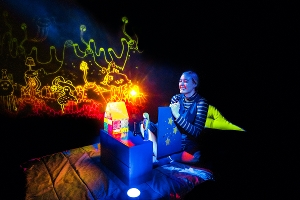 JUNIOR, the International Children's Festival, takes centre stage at Harbourfront this holiday weekend. In fact, it's more than just a stage; the entire grounds of Harbourfront Centre will become a playground for the imagination of children ages 5-12 and their families. Children are invited to choose their own adventure from a large menu of artistic work from around the globe, from plays, parades, music, murals and scavenger hunts to cooking and dance workshops, and to wander around the grounds for encounters with participatory performances. (Preregistration here is encouraged for some indoor shows.) BroadwayWorld spoke with co-curator Lisa Marie DiLiberto to find out what people can expect from the festival.
JUNIOR, the International Children's Festival, takes centre stage at Harbourfront this holiday weekend. In fact, it's more than just a stage; the entire grounds of Harbourfront Centre will become a playground for the imagination of children ages 5-12 and their families. Children are invited to choose their own adventure from a large menu of artistic work from around the globe, from plays, parades, music, murals and scavenger hunts to cooking and dance workshops, and to wander around the grounds for encounters with participatory performances. (Preregistration here is encouraged for some indoor shows.) BroadwayWorld spoke with co-curator Lisa Marie DiLiberto to find out what people can expect from the festival.
BWW: Tell us a little bit about what the goal is behind JUNIOR, the International Children's Festival.
LISA: JUNIOR is not a new festival; I believe it's in its fifth year this year, but there's been a pandemic in between. This is my first year as the co-curator, and we're really thinking a lot about how the work can meet kids in different ways, and offer different ways that they can participate or intersect with the work. We're looking for accessible work, asking: How can the work be digestible for the kids? How can it spark their curiosity? How can they find their way into it from different angles?
My background is in participatory site-specific immersive work. So this year, the goal really is that the kids will come to the site and feel like they're embarking on an adventure. Wherever they go, they'll find something to jump into to connect with. We've really tried to place things all over the site; there's a lot of interactive promenade roaming kind of work, a lot of work that they can participate in, a lot of workshops. I think that's the goal of Junior this year: for kids to really feel like they're part of it. To have them being active participants in the shows and the workshops and the onsite kind of action.
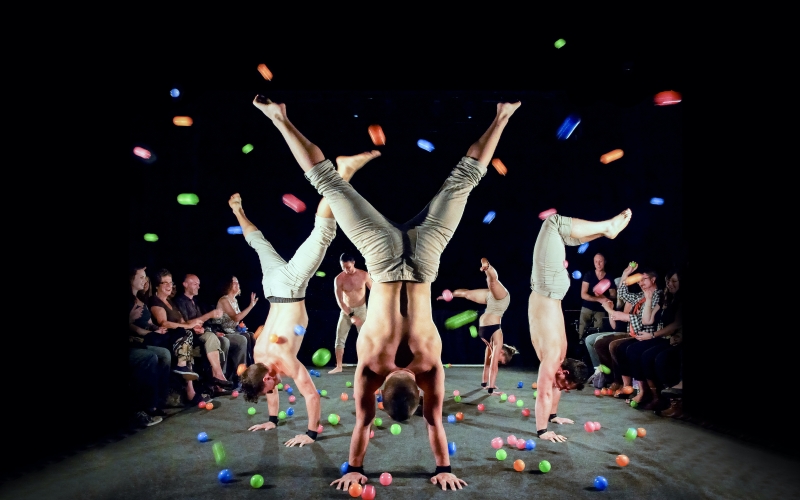
Photo of A SIMPLE SPACE by Andy Phillipson
BWW: So most of the shows have some kind of participatory element?
LISA: Almost all of them. There are some shows that are really up close and personal. For example, we have this acrobatic show from Australia, called A SIMPLE SPACE, on the south lawn. Usually, this kind of show might be on the concert stage where the audience is a little distanced from the piece. But in this case, because of the nature of the show, the kids are sitting along 3 sides on the ground, so they can see the acrobats up close and personal.
In another show we have in one of the big theaters, called ZOOOM, also from Australia, the kids take "a piece of dark," whatever that means to them, and they exchange it for a light as they go into the theater. And then there's times within that show that they shine their light and participate in that show, even though in that case they're sitting in seats.
There's an immersive scavenger hunt called STORYBOOK SEARCH from Bad Hats Theater, who you might be familiar with, they're quite an up-and-coming theater company for young audiences in Toronto, and they're doing a site-specific piece that promenades all the way across the grounds, even over to the East Side, where there's not much programming. They take small groups of children, and as they put together fairy tales and stories, they find the pieces together with the kids at different places along the ground. They put together the pieces of the story, and and then come back. It's very tactile and moving.
Hopefully, people will know that they can just show up, and they'll find adventure. They'll of gravitate towards the things that they love. And also people can book their tickets in advance, for the theater shows inside.
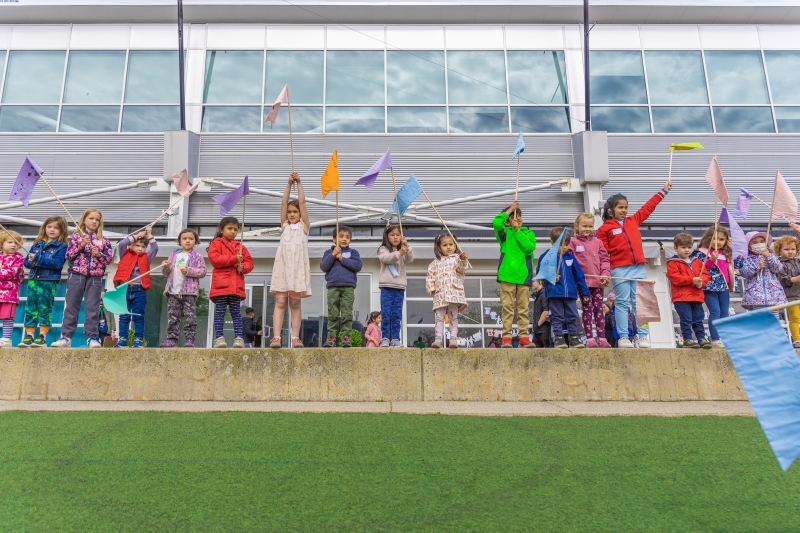
Photo of STORYBOOK SEARCH by Brian Medina
BWW: And it's not just theatre. How are you engaging kids in other multidisciplinary and multi-sensory ways?
LISA: My background is in theater and performance, but Natalie Bonjour also has a background in dance and visual arts. So there is a visual arts element in a big mural-making piece by Muse Arts. There's a small film component curated by imagineNATIVE, five short films that are playing throughout the day. And then there's this amazing piece called FAMILY PORTRAIT from Scotland, from the UK, that I saw at this festival in Norway, called Showbox. I went with my son, who's 9, and it was so emotionally resonant we both cried by the end of it. It's about this mother and her three kids. She's a dancer, the artistic director of a ballet company in Scotland, and she is doing this kind of improv dance with her kids in nature, and you get to know the three of them, and her. It really is so resonant, because it's about how movement and nature and family are connected. It's on four screens, too. So you sit in the middle and you watch them move around you and spin. I'm really excited for people to see that piece.
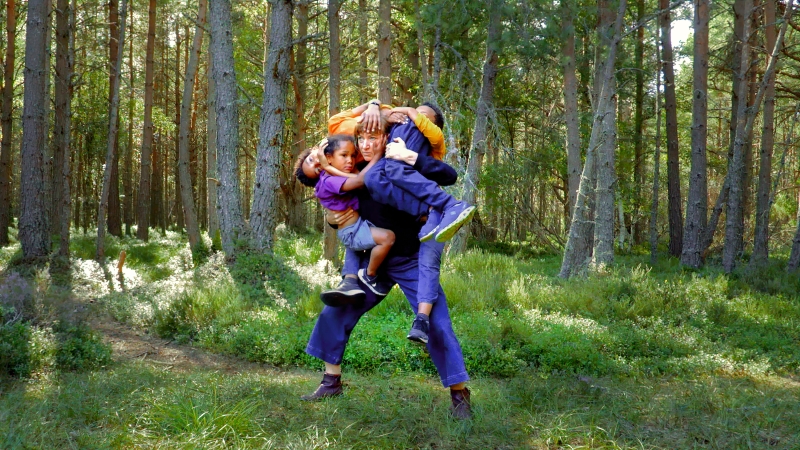
Photo of FAMILY PORTRAIT by Natasha Gillmore and Robbie Synge
BWW: So it's a 360 experience.
LISA: That's right. You're more immersed in the piece. You're not just sitting and watching something, but you're participating, or inside of it, and that seems to be hopefully the way for most of the work that we have at JUNIOR this year.
BWW: How do you and Natalie Bonjour navigate the curation process?
LISA: Well, there were some pieces that were already booked, that meant to go on in 2020, or 2021. Many of them are coming this year, like A SIMPLE SPACE and ZOOOM. And then really, we just respond to different artists who send submissions through videos. We travel to festivals, and then we discuss what might fit in the festival, and why and how it fits together. Then themes emerge through that. We don't necessarily start with a theme of adventure. We started by thinking about the kind of work that we wanted, looking at the big picture, the map, the space, the venues that we have, the shows that we're interested in, making sure it's multi-disciplinary.
Sometimes things happen spontaneously. This year, we have an amazing food program called THE NOIR EXPERIENCE, which involves three young Black chefs who will be cooking up their favorite dishes, teaching it to kids, and then they'll be bringing home some of that food. Natalie met a local chef at a restaurant in our neighborhood, and they were talking about the fact that there aren't many young Black chefs being trained, or being given opportunities. So together they came up with this program.
Other times, it's a long relationship, for example, Bad Hats was commissioned last year to develop their piece, so they had a workshop presentation. This year, they're presenting the the production with our support and with the support of some of the arts councils as well. A lot of the pieces have been a long time coming because of the pandemic. For the international work, there's still a backlog of work that was meant to come, because Natalie is thinking these things through years ahead, and so are the international companies. To come from Australia, you need to build a whole tour in order to make it worthwhile. So most of the international pieces are on a some kind of international tour or national tour across Canada, which means that, while we don't work formally together, we're always in discussion with those festivals.
BWW: What do you find is the benefit of putting together a festival that includes international work, rather than doing a festival with only local artists?
Lisa: First of all, I think we've got a balance of those things. There's a lot of local artists, especially Toronto-based artists, in the festival this year. But the international work offers that opportunity for young people to see work from different countries, and it's one of the only festivals in this area that presents international work for kids of this age. I think that's a really exciting thing for kids, to see what's happening, other forms from other countries. What's happening there, and how it fits together with what they're seeing here. I think it's also great for the artistic community to get a sense of what kind of Theatre for Young Audiences work is happening around the world.
Because of the pandemic, this will be for some kids one of the first times they see a work from another country! Then, they get a chance to talk to the artist from Denmark, or the artist from Australia, artists, you know, that are coming from from different countries. It gives an opportunity for the local artists from Toronto and nationally from Canada to connect with International Artists and for International Artists and companies to see their work and vice versa. A lot of the time, children's theatre is so hyper-local. You don't see nearly as many international festivals for children's theatre as you do for other types of theater, and there aren't nearly as many opportunities for companies that are doing work for children to interact on an international level.
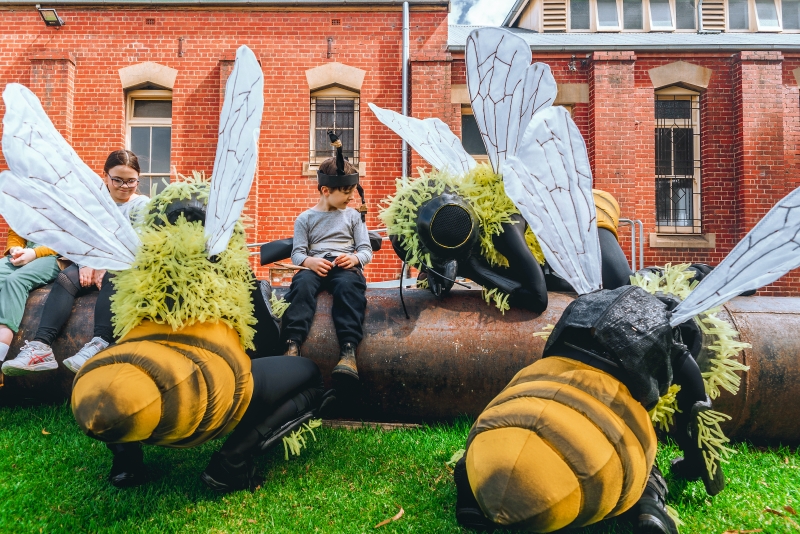
Photo of THE BEES by Theresa Harrison
BWW: One of the things that I really appreciate about this festival is how in intentionally it foregrounds the experience of children. While everyone who works in children's theatre is very dedicated to what they do, it's not a usual thing in Canada to see such care and intentionality in programming for children.
LISA: That's a really good point, because JUNIOR is for kids. It's for kids, 5 to 12. Other kids who are younger and older can find their way. But I think it's really important as a curator to know whose experience is being centered in at this festival, and it's the experience of the kids. The parents, the younger kids, the older kids, they're accompanying the kids that this is for, which is kids age 5 to 12.
I hear you what you're saying, that theater for young audience sort of has a lower status, or it's not valued as much in Canada. However, having traveled, just last year I was in Berlin, Stockholm, Amsterdam. I was at the Showbox Festival in Oslo, even over in Belgrade seing different work, and over there, particularly in the Western European countries, when I mentioned that I run a Theater for Young Audiences company, and that I'm having a Theater for Young Audiences festival, I was put up on a pedestal, actually, because there the work is a priority. The work is valued above, or definitely at the same level, as the work that's happening on the national stage. They have national stages presenting work for young audiences, so there's a different kind of exploration, rigor, artistic sensibility and dedication and value for the work created for young audiences in other countries.
We don't have that here yet. I'm hoping that through things like the JUNIOR festival, by exposing our artists, our audiences to high caliber work for young audiences, we can start to shift that mindset. To elevate the way that it's perceived here in Canada, because it's certainly important, and it's certainly sophisticated, and certainly takes as much rigor and artistic concentration, focus, resources, perhaps more, because it's very particular audience.
BWW: It's very difficult to engage children. When you engage them, they engage perhaps more than any other audience.
LISA: Absolutely.
BWW: But it is difficult to get and maintain their attention. You have to make every word count so much more. What do you find engages young audiences the most?
LISA: I think, what really engages them is when they can be part of the work, part of the experience. When they're not told they have to sit quietly and listen and behave, although those are things to learn about being in the theater. But I think it's our responsibility to engage them, to bring them along. There are ways to do that do include certain kinds of parameters and rules but I think it needs to be different than the classroom experience they have. There are more creative ways for them to follow. For me, it really is the participatory nature of the work that resonates with with kids of this age. And of course, the content, the stories, talking about things that they care about, understanding where they're coming from.
We did this workshop recently at Theater Direct with the National Theater of Sweden, and they were reminding us what it's like to have a kid's perspective. You know that when the kids come they've just been brought there. They didn't necessarily choose to go to the show. They didn't necessarily decide what to have for breakfast. They don't have much agency. So when they come to you, how can you give them some of that agency? How can you let them know that you acknowledge where they're coming from, that they're here, and how can you so meet them there, by giving them some agency to participate or not participate?
Because they're told what to do a lot. So how can theater like allow them to make some decisions?
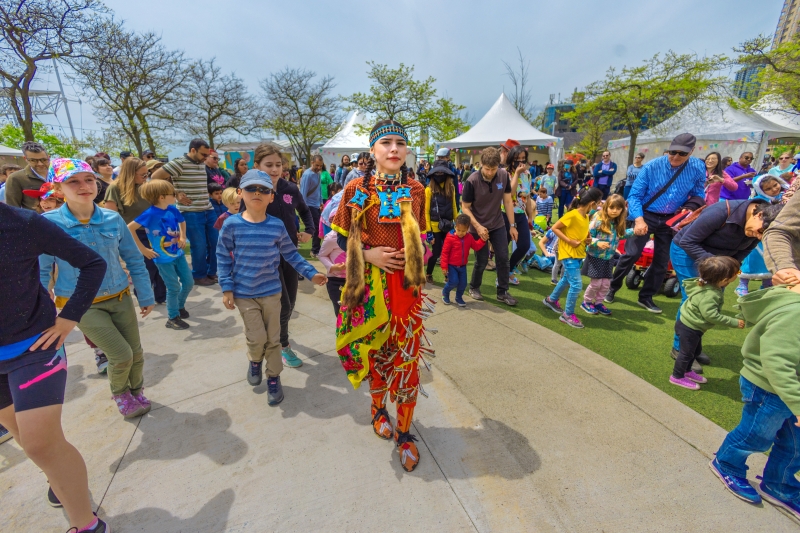
Photo of All Nations Junior Drummers First Fire Dance by Brian Medina
BWW: So you're turning participation into a sense of co-ownership, rather than something else they're being told to do.
LISA: That's right. "Do this, clap your hands now" - when that starts, they're being demanded. Instead, we can craft their experience. We can invite them to do certain things in certain ways, but that's the that's the art, how to do that. That's what why artists are creating these experiences. It's a tough and delicate balance.
Also, though, kids are such a wonderful audience. Because they are more willing to suspend disbelief, more willing to participate in things wholeheartedly.
BWW: But they can also sense inauthenticity very easily.
LISA: Oh, yeah.
We learn to behave a certain way in the theater, and they're being taught that. But they still don't know all of the etiquette and rules. So if they're not engaged, they may just start talking or act out, or close their eyes, or they don't necessarily know it's rude to fall asleep at the show. They don't know that you're not supposed to talk or respond. That's so amazing, because we can capture that. We can capture that impulse to respond, to participate, in a positive way. As adults, when we're invited to participate, we're worried. We're stressed, because we're we think we're not supposed to. But kids are at that age when they don't quite know that rule yet, so we can capture them. It's just our job to capture them in a way that is going to inspire their imaginations.
I was just directing a show at Presentation House Theatre in Vancouver, which was an immersive game room experience about mental health. It was grade sevens and eights. It's very interactive and immersive.
And there was no way we could have predicted how the grade sevens and eights would be in that space, solving puzzles. The development had to include six shows with kids experiencing the piece so we could see what they would do, and how they would react. That gave us so much information. It's hard to rehearse and plan for a participatory show without the participants.
While there are a couple of premieres at the festival, many of them have been touring all around the world or around the country, so they've all worked with audiences before.
Photo of Luca "Lazylegz" Patuelli by JASPER
BWW: You're an advocate for artist caregivers and accessibility in the arts. How does the festival embrace that ethos of accessibility?
LISA: We've had a really awesome access producer on this project called Erica May, and she's been coordinating all of the points of access and working with different consultants. This year there are ASL-interpreted shows with audio description for some of the pieces, and there's also a "chill out" zone this year, and a sensory area to allow kids to experience the shows through in different ways.
Balancing Act is the national initiative that we have here at Theater Direct which supports artists and arts workers who are caregivers in the performing arts. Harbourfront Centre was a partner with us last year, and we are working with them on how to support artists touring with children. So they've created a policy around that.
Where that comes in with JUNIOR is that we have onsite childcare. It sounds really strange, because it's a children's festival, but through my own experience and from watching people move through different festivals, when you have a little toddler and an 8 year old, and you want to go see a show in a theatre that's interactive and participatory in nature and where the experience of the 8 year old is centred, it's a little bit difficult to bring them both.
So, this year, we have engaged the Summerhill Club to take care of some of those toddlers and babies, so that parents can be freed up to engage more fully in the experience of JUNIOR with their kids that are between 5 and 12. We'll see how that goes and how many people take advantage of that. Parents are juggling so many different things as caregivers, so that creates a different kind of access, because those parents can then come to the festival with their older kids and know that their younger kids are safe and taken care of while they experience those shows. It doesn't mean that the babies and the toddlers aren't allowed to come inside, but for them to sit there for an hour and a half is a lot to ask, even if they are participating.
BWW: A lot of parents have children at multiple ages, and a 2 year old and an 8 year old have very different needs and very different experiences. I think that's a fabulous idea, and I hope that a lot of people use it.
LISA: I do, too. I really do. It reminds me that we are centering the experience of the kids 5 to 12. They're going have a more enriching experience if they can stay for the entire show. We can't really leave a 6 year old by themselves in a theater for an hour and a half without their parent, they'll be stressed out. They'll also be stressed out if they have to come in and out because they're there with a toddler who's welcome to come in and out, but that's not necessarily supporting the experience of the kids who this festival has been created for.
BWW: It can be tough to be an older sibling, because all of a sudden you go from being the center of the family to being a big brother or big sister, and your experience can get pushed aside because the younger sibling has more needs than you do.
LISA: Or, if you're a single parent, too, there's no option to leave one kid home and bring the other. That's not an option that everybody is afforded, or if you're someone who works on the long weekend because they're not working a 9 to 5 office job. So it also opens up access for other kinds of folks to to come to the festival, who may not be able to hire a babysitter, or who work on the weekends, or who are single parents.
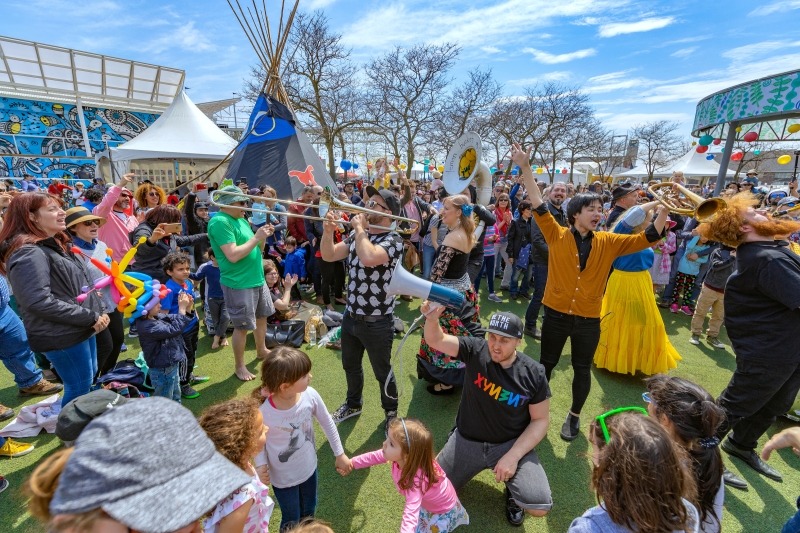
Photo of the Lemon Bucket Orkestra by Brian Medina
BWW: Is there anything else about the event that you are really excited about?
LISA: Well, there's just so much happening. So I think the big thing is just come and see what kind of adventure the day might take you on, because there are really so many paths to take through the festival.
There's the Lemon Bucket Orchestra; they're going to be doing a parade every day and playing on the concert stage.
The festival is opening with the Toronto Symphony Youth Orchestra, so there's a lot of work by emerging artists or younger artists, so that kids between the ages of 5 and 12 can see themselves, and how they might participate as artists in a festival like this, where practicing various art forms might lead them.
There's a lot on stage in the park. Luca "Lazylegz" Patuelli, who is a disabled break dancer, will be performing with a live DJ. Naghmeh Farahmand is performing with a a group of emerging artists who are percussionists. And one giant thing that's really hard to miss is there's a giant ocean map from Ocean Week Canada right on the lawn, with pathways of all the different kinds of waterways, indigenous waterways and modern day waterways layered on top. It's also an AR and VR experience. If you have your phone or one of the tablets on site, you can explore that even deeper and learn from Indigenous Water Guardians and coastal communities.
There's more, but people will just have to come down with their families to check it out, to really, really get a sense of what's here.
BWW: I'm almost jealous that I'm no longer 5 to 12 years old!
LISA: You can come, too. I think artists and theater people will really enjoy the festival. There's a piece from Denmark called PINOCCHIO, it's a clown, puppetry piece. It's a little bit dark. I think it's going to be really fantastic!
Harbourfront's JUNIOR festival runs from May 20-22. For more information, visit https://harbourfrontcentre.com/series/junior/
Cover photo of ZOOOM by Matt Byrne
Comments
Videos

